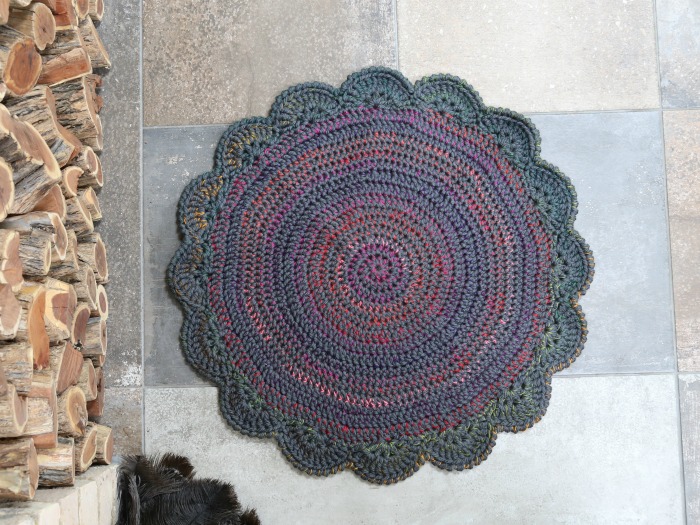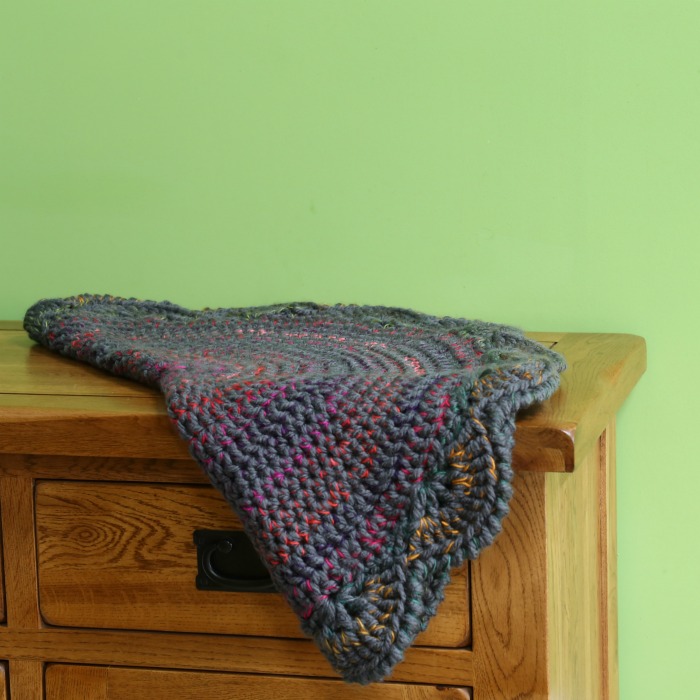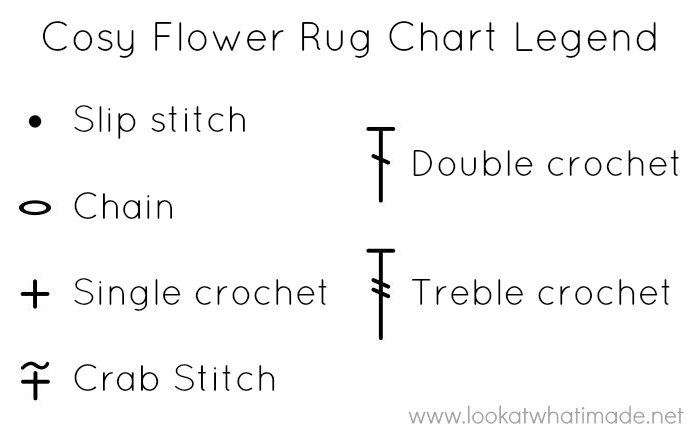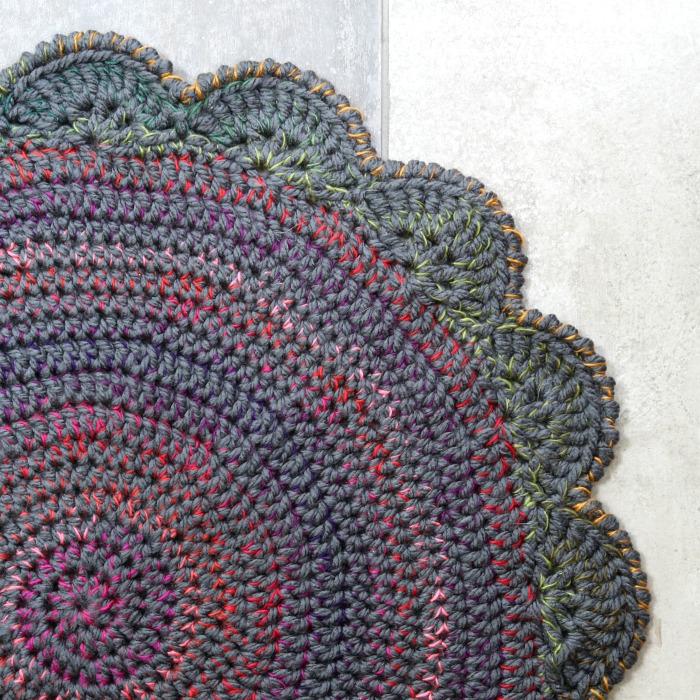The Cosy Flower Rug uses three strands of yarn held together to create a sturdy fabric with a subtle ombre effect. The size is easy to customise too. I think I want to make a jolly big one next!

I designed this rug for Issue 97 of Inside Crochet way back in December 2017. I chose my colours to reflect the sights/sounds/smells of Christmas in the Karoo, married with the cosiness of Christmas in the UK. You are, of course, free to change your colours to better reflect your own story.
My nostalgia always kicks into overdrive around Christmas time. The South African Christmases of my youth were short-sleeved, jolly affairs, with family members descending in droves. There were watermelon fights, family barbeques, and early-morning swims; late night hide-and-seek in the orchard and Rummikub around the kitchen table; cold ham with salads and mustard aspic, and the lazy hum of ostriches and cicadas at dusk.
Although I miss these big family gatherings more than I can say, I have become accustomed to, and quite fond of, our smaller White Christmases (though there’s not been much snow to speak of in the last few years!). There is something undeniably magical about Christmas in Winter. From a crafting point of view, crocheting by the light of the twinkling Christmas tree is as close to crafty bliss as it is possible to be. The serenity – so at odds with the rest of the year – is sorely needed and much appreciated.
I hope you enjoy making this rug!
Cosy Flower Rug Pattern
©Dedri Uys 2017. All Rights Reserved.
Add This Pattern to Your Ravelry Queue

Materials
- Scheepjes Chunky Monkey, 100% acrylic, 100g/116m/127yds
- Yarn A: Dark Grey (2018) x 7 balls**
- Scheepjes Wanderlust, 100% acrylic, 100g/232m/253yds
- Yarn B: Paris (466) x 1 ball
- Yarn C: Rudesheim (468) x 1 ball
- 9mm crochet hook
** For the original pattern, I used 1 strand of Scheepjes Roma Big (100% acrylic, 220g/132m/144yds) x 3 balls for Yarn A. This yarn is not readily available anymore, but feel free to use it if you still have some in your stash.
Gauge
Your rug should measure 12cm/4.7” at the end of Round 3.
Size
74cm/29”
Abbreviations
US Terminology (UK version available in Issue 97 of Inside Crochet – please note suggested yarn change above)
- Ch – Chain
- Dc – Double crochet
- Hdc – Half-double crochet
- Sc – Single crochet
- Sl st – Slip stitch
- St/sts – Stitch/stitches
- Tr – Treble crochet
Punctuation
- *Asterisk – Repeat instructions between asterisks the number of times specified.
- () Parentheses – Repeat instructions between parentheses the number of times specified.
Special Stitches and Techniques
Crab stitch (Reverse single crochet):
The Crab stitch is worked in the same way as the single crochet, except that you work backwards. It forms a knot-like stitch that is perfect for edgings.
To make a crab stitch, swing your hook under your hand, by twisting your wrist, and insert it into both loops of the stitch BEFORE the stitch you just worked into. Yarn over and pull up a loop. Yarn over and pull through both loops on your hook.
Continue making your stitches in this way, inserting your hook into both loops of the stitch before the stitch you just worked into each time. You can find a video tutorial by It’s All in a Nutshell HERE.
Chart Legend
I have supplied a chart for the edging only (Rounds 17 – 19). You can find it after the instructions for Round 19.

Notes
Work with two strands of Yarn A and one strand of Yarn B or C held together (as indicated in the pattern).
This pattern is worked in a spiral, so there is no need to join at the end of each round.
The body of the rug consists of a combination of hdc and dc rounds.
- If you find that your rug ‘bowls’ (doesn’t lie flat), change one or two dc rounds to hdc.
- If your rug wobbles/ruffles, change a few hdc rounds to dc.
If you want to make a bigger rug, you can keep adding rounds until your rug is as large as you want it to be. As long as the final round has a multiple of 10 stitches, the edging will work out.
Instructions
With two strands of Yarn A and one strand of Yarn B held together, make an adjustable ring, leaving a 10cm/4” tail.
Round 1: Ch 1 (doesn’t count as a st throughout), sc into the ring. Make 9 hdc into the ring. {1 sc and 9 hdc}
Round 2: Make 2 hdc in each st around. {20 hdc}
Round 3: (Make 2 hdc in the next st, hdc in the next st) 10 times. {30 hdc}
Round 4: (Make 2 hdc in the next st, hdc in the next 2 sts) 10 times. {40 hdc}
Round 5: (Make 2 hdc in the next st, hdc in the next 3 sts) 10 times. {50 hdc}
Round 6: (Make 2 hdc in the next st, hdc in the next 4 sts) 10 times. {60 hdc}
Your rug will wobble slightly at the end of this round. That will be corrected in the next 3 rounds.
Round 7: (Make 2 dc in the next st, dc in the next 5 sts) 10 times. {70 dc}
Round 8: (Make 2 dc in the next st, dc in the next 6 sts) 10 times. {80 dc}
Round 9: (Make 2 dc in the next st, dc in the next 7 sts) 10 times. {90 dc}
Round 10: (Make 2 hdc in the next st, hdc in the next 8 sts) 10 times. {100 hdc}
Round 11: (Make 2 hdc in the next st, hdc in the next 9 sts) 10 times. {110 hdc}
Round 12: (Make 2 hdc in the next st, hdc in the next 10 sts) 10 times. {120 hdc}
Round 13: (Make 2 hdc in the next st, hdc in the next 11 sts) 10 times. {130 hdc}
Round 14: (Make 2 hdc in the next st, hdc in the next 12 sts) 10 times. {140 hdc}
Round 15: (Make 2 dc in the next st, dc in the next 13 sts) 10 times. {150 dc}
Round 16: (Make 2 dc in the next st, dc in the next 14 sts) 9 times. Make 2 dc in the next st, dc in the next 13 sts, hdc in the last st. {159 dc and 1 hdc}
Cut Yarn B and add one strand of Yarn C.
Round 17: Sc in the next 3 sts. *Skip the next 2 sts, (dc, ch 1) 4 times into the next st, dc in the same st. Skip the next 2 sts, sc in the next 5 sts.* Rep from * to * 14 more times. Skip the next 2 sts, (dc, ch 1) 4 times into the next st, dc in the same st. Skip the next 2 sts, sc in the next 2 sts. {80 sc, 80 dc, and 64 ch-1 sps}
Round 18: *Sl st in the next st and skip the next 3 sts. (Make 3 tr in the next ch-1 sp) 4 times, skip the next 3 sts.* Rep from * to * 15 more times. Join to the first sl st with a sl st. {192 tr and 16 sl sts}
Round 19: (Crab stitch in the next 12 sts**, skip the next sl st) 15 times. Crab stitch in the last 12 sts. Join to the first Crab stitch with a sl st. Fasten off and work away your ends. {192 Crab stitches}
** I prefer making the Crab stitches in the back loop only of the previous round as it creates a pretty little ridge. You might prefer the sturdiness of working through both loops. I leave the decision up to you.


And there you have it: One simple, joyful rug.
One of the things I really enjoy about working with multiple strands of yarn (apart from the fact that projects grow super quicky) is that I can paint with colours. I have made many beautiful rugs using scrap yarn in different weights and types. I just love it!!!

This blog post contains affiliate links. I only link to products I personally use or would use. All opinions are my own.



Vicki Lyle says
Absolutely gorgeous!! I’m going to crochet this.I must tell you about my version of your paint splatter pattern. I don’t have a finished version pic that I can send but I will figure that out. I believe you are my muse! lol I went wild with the paint splatter/pallet theme. Little gift bags/key chains/popsicles, etc. Thank you gifts especially for my fellow artistic friends. I give you the credit to you to the friends I sent “in process” pics from my cell. My FB page is sick. Have to get this mac to the shop for repairs. Thank you for all your inspiring work.
Karen says
I am rather new to crochet and knitting and maybe this is a silly question but for making a crochet rug like this and putting it on the floor doesn’t it get worn out fast and very dirty? How do you manage to keep these looking fresh without having to wash all the time.
Dedri Uys says
Hi Karen. I have one rug that my granny gave me (made almost 40 years ago) that is still going strong in spite of all the usage it gets. I wash my rugs once a month, sometimes every two months, depending on where they live (some live over the back of our couch). They still look pretty good, even after 5 years minimum of constant use.